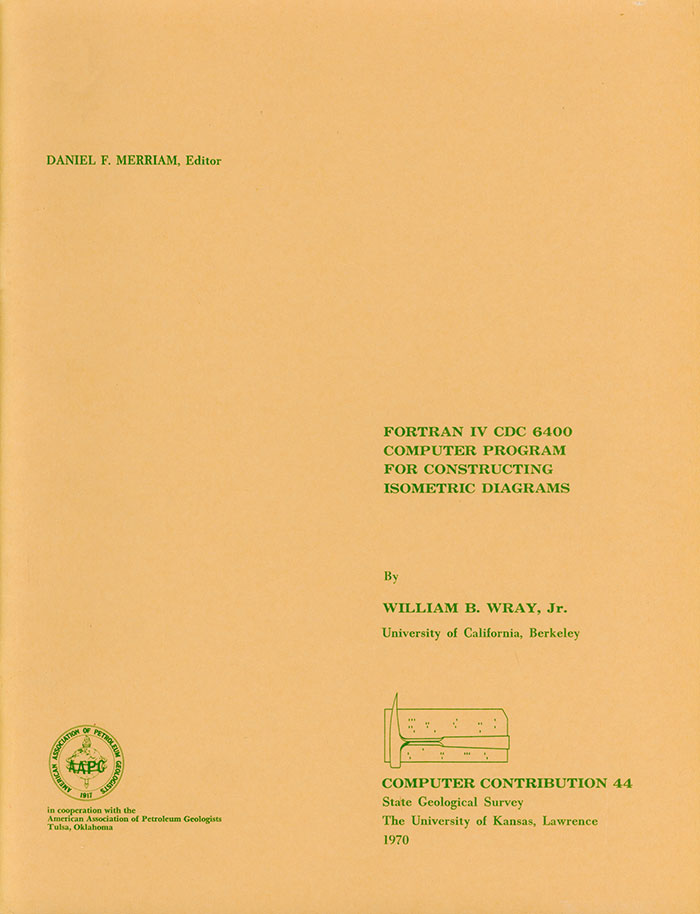

Kansas Geological Survey, Computer Contributions 44, originally published in 1970
FORTRAN IV CDC 6400 Computer Program for Constructing Isometric Diagrams
by William B. Wray, Jr.
University of California, Berkeley

Originally published in 1970 as Kansas Geological Survey Computer Contributions 44.
Introduction
Isometric pictorial representation has long been favored by geologists as a means of displaying three-dimensional surfaces and bodies. A principal advantage over perspective representation is that plotting and measurement can be made readily anywhere on the diagram. Lobeck (1924, p. 120-121) lists the following properties of isometric diagrams.
- "Measurements may be made to scale anywhere upon the upper surface of the block in the direction of either of the two coordinates, which in the object itself are at right angles to each other.
- Distances in other directions are not commensurate with each other unless measured along lines parallel to each other, and they are not commensurate with distances measured on the sides of the block.
- All the lines parallel in the object itself are parallel in the isometric drawing.
- All lines vertical in the object are vertical in the drawing.
- If the vertical scale of the drawing is the same as its horizontal scale, then the measurements made in the direction of any of the three coordinates are commensurate.
- All angles in an isometric drawing are distorted, and even two angles lying in the same plane cannot be compared with each other unless they lie in exactly similar positions. "
The I3D subroutines included with this contribution provide an efficient and fast method of displaying a surface—a single valued function of two variables—in isometric or similar pictorial representation. Numerous options are available through the ISPECS and RSPECS parameter arrays. Among the most important options
- The diagrams can be seen from all theoretically possible viewpoints.
- The data can be viewed in an unlimited number of rectangular subblocks, all automatically spaced to avoid point overlap (x and y direction spacings are variable). Any rectangular subarea within the data array area may be considered for plotting and any number and configuration of rectangular subblocks within this subarea may be skipped if desired.
- Scale, line and point spacing, and density of lines and points to be plotted are variable.
- The vertical (z) scale may be expanded or contracted relative to the horizontal (x, y) scale without restriction. Distances in x and/or y directions can be stretched or foreshortened independently, with scale remaining constant.
- Surfaces may be plotted with or without the traditional block diagram frame, and major and minor scale ticks are available. A standard labelling routine can be used.
- Data input is flexible. Points can be arranged in north-south (y direction) or east-west (x direction) grid lines.
Possible applications of isometric pictorial representation can be considered within the framework of four general types of surfaces.
- North-south, east-west, elevation surfaces, such as topographic surfaces, tops and bottoms of beds, buried bedrock surfaces, etc.
- North-south, east-west, z surfaces, where z is any measurable quantity, such as, for example, thickness or percent of sand in a sedimentary bed, or Bouguer anomalies.
- X-y-z surfaces, for example equilibrium surfaces in chemical stability diagrams.
- X-y-f(x, y) surfaces, mathematical functions of two variables, including functions of many terms where the values at different points cannot be readily visualized. Many preceding papers in the Computer Contributions series deal with functions of this type. Examples are the double (two-dimensional) polynomial and Fourier series currently important in trend-surface and harmonic and spectral analysis.
Because of wide interest in computer graphics, a number of algorithms have been written which have the capability of generating three-dimensional diagrams (e.g. Rohlf, 1969). Almost all of the algorithms produce perspective rather than isometric diagrams and most have more-or-less serious bugs and severe limitations in point-array size due to rapid increase of execution time with increase in number of points (A.R. Paradis, personal communication). Algorithms to construct isometric diagrams seemingly are less common, as I do not know of any, other than I3D.
The I3D subroutines have been subjected to thorough testing, and numerous isometric drawings have been obtained, but it is entirely possible that algorithm defects are present due to the complexity of the subroutines.
Acknowledgments
Mr. Arthur R. Paradis, in charge of computer graphics at the University of California, Berkeley, Computer Center, gave encouragement and arranged use of computer facilities during the program development. His methodology is evident in both the organization of the latter half of this paper and in the subroutine structuring. The Anaconda Company provided some development computer time and permitted use of the view of the Berkeley open-pit mine in Example 2. Prof. Charles Meyer, Prof. Garniss Curtis, and Mr. Paradis kindly reviewed the manuscript.
The complete text of this report is available as an Adobe Acrobat PDF file.
Read the PDF version (9.4 MB)
Kansas Geological Survey
Placed on web Sept. 11, 2019; originally published 1970.
Comments to webadmin@kgs.ku.edu
The URL for this page is http://www.kgs.ku.edu/Publications/Bulletins/CC/44/index.html

